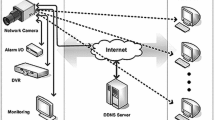Abstract
This paper describes the design and implementation of a hybrid intelligent surveillance system that consists of an embedded system and a personal computer (PC)-based system. The embedded system performs some of the image processing tasks and sends the processed data to the PC. The PC tracks persons and recognizes two-person interactions by using a grayscale side view image sequence captured by a stationary camera. Based on our previous research, we explored the optimum division of tasks between the embedded system and the PC, simulated the embedded system using dataflow models in Ptolemy, and prototyped the embedded system in real-time hardware and software using a 16-bit CISC microprocessor. This embedded system processes one 320 × 240 frame in 89 ms, which yields one-third of the rate of 30 Hz video system. In addition, the real-time embedded system prototype uses 5.7 K bytes of program memory, 854 K bytes of internal data memory and 2 M bytes external DRAM.
Similar content being viewed by others
References
J.K. Aggarwal and Q. Cai, “Human Motion Analysis: A Review,” Computer Vision and Image Understanding, vol. 73, no. 3, 1999, pp. 428–440.
I. Haritaoglu, D. Harwood, and L. Davis, “W4: Who, When, Where, What: A Real Time System for Detecting and Tracking People,” in Proc. Int. Conf. on Automatic Face and Gesture, Nara, April 1998, pp. 222–227.
I. Haritaoglu and L. Davis, “Hydra: Multiple People Detection and Tracking Using Silhouettes,” in Proc. IEEE Work. on Visual Surveillance, Fort Collins, Colorado, June 1999, pp. 6–13.
N. Oliver, B. Rosario, and A. Pentland, “A Bayesian Computer Vision System for Modeling Human Interactions,” IEEE Transactions on Pattern Analysis and Machine Interlligence, vol. 22, no. 8, Aug. 2000, pp. 831–843.
A. Pentland, “Looking at People: Sensing for Ubiquitous and Wearable Computing” in IEEE Transactions on Pattern Analysis and Machine Intel., vol. 22, no. 1, Jan. 2000, pp. 107–119.
P. Mahonen, “Wireless Video Surveillance: System Concepts,” in Proc. Int. Conf. on Image Analysis and Processing, Sep. 1999, pp. 1090–1095.
Y. Shirai, J. Miura, Y. Mae, M. Shiohara, H. Egawa, and S. Sasaki, “Moving Object Perception and Tracking by use of DSP,” in Proc. of Computer Architectures for Machine Perception, Nov. 1993, pp. 251–256.
K. Sato and J.K. Aggarwal, “Temporal Spatio-Velocity Transform and its Application to Tracking and Interaction,” Computer Vision and Image Understanding, vol. 96, issue 2, Nov. 2004, pp. 100–128.
K. Sato and J.K. Aggarwal, “Tracking Objects Using Temporal Spatio-Velocity Transform,” in Proc. IEEE Work. on Performance Eval. of Tracking and Surveillance, Kauai, Hawaii, Dec. 2001.
Ptolemy Project, Department of Electrical Engineering and Computer Sciences, University of California at Berkeley, http://ptolemy.eecs.berkeley.edu/.
K. Sato, B.L. Evans, and J.K. Aggarwal, “Designing an Embedded Video Processing Camera Using a 16-bit Microprocessor for Surveillance System,” in Int. Work. on Digital and Computational Video, Clearwater, FL, Nov. 2002, pp. 151–158.
Author information
Authors and Affiliations
Corresponding author
Additional information
Koichi Sato is a Ph.D. student in the Department of Electrical and Computer Engineering at The University of Texas at Austin. He earned his B.S. in University of Tokyo, Japan in 1993. He worked for Automotive Development Center in Mitsubishi Electric Corporation where he was involved in lane and automobile recognition in vehicle video processing products such as automatic cruise control and drowsiness detection systems. He enrolled in the current University at 1998 and received an M.S in 2000. In his Master's thesis he worked on human tracking and human interaction recognition. His current work includes velocity extraction using the TSV transform, object tracking, and 3D object reconstruction.
Brian L. Evans is a tenured Associate Professor in the Department of Electrical and Computer Engineering at The University of Texas at Austin. His research and teaching efforts are in embedded real-time signal and image processing systems. In signal processing, his research group is focused on the design and real-time software implementation of ADSL and VDSL transceivers, for high-speed Internet access. In image processing, his group is focused on the design and real-time software implementation of high-quality halftoning for desktop printers, smart image acquisition for digital still cameras, and 3-D sonar imaging systems. In signal and image processing, Dr. Evans has published over 100 refereed conference and journal papers. Dr. Evans is the primary architect of the Signals and Systems Pack for Mathematica, which has been on the market since October 1995. He was a key contributor to UC Berkeley's Ptolemy Classic electronic design automation environment for embedded systems, which has been successfully commercialized by Agilent and Cadence. His BSEECS (1987) degree is from the Rose-Hulman Institute of Technology, and his MSEE (1988) and PhDEE (1993) degrees are from the Georgia Institute of Technology. From 1993 to 1996, he was a post-doctoral researcher in the Ptolemy project at UC Berkeley. He is a member of the Design and Implementation of Signal Processing Systems Technical Committee of the IEEE Signal Processing Society, and a Senior Member of the IEEE. He is the recipient of a 1997 National Science Foundation CAREER Award.
J.K. Aggarwal has served on the faculty of The University of Texas at Austin College of Engineering since 1964 and is currently Cullen Professor of Electrical and Computer Engineering and Director of the Computer and Vision Research Center. His research interests include computer vision and pattern recognition focusing on human motion. A Fellow of IEEE since 1976 and IAPR since 1998, he received the Senior Research Award of the American Society of Engineering Education in 1992, the 1996 Technical Achievement Award of the IEEE Computer Society and the graduate teaching award at The University of Texas at Austin in 1992. He has served as Chairman of the IEEE Computer Society Technical Committee on Pattern Analysis and Machine Intelligence (1987--1989); Director of the NATO Advanced Research Workshop on Multisensor Fusion for Computer Vision, Grenoble, France (1989); Chairman of the IEEE Computer Society Conference on Computer Vision and Pattern Recognition (1993), and President of the International Association for Pattern Recognition (1992--1994). He is a Life Fellow of IEEE and Golden Core member of IEEE Computer Society. He has authored and edited a number of books, chapters, proceedings of conferences, and papers.
Rights and permissions
About this article
Cite this article
Sato, K., Evans, B.L. & Aggarwal, J.K. Designing an Embedded Video Processing Camera Using a 16-bit Microprocessor for a Surveillance System. J VLSI Sign Process Syst Sign Image Video Technol 42, 57–68 (2006). https://doi.org/10.1007/s11265-005-4163-z
Received:
Revised:
Accepted:
Published:
Issue Date:
DOI: https://doi.org/10.1007/s11265-005-4163-z




